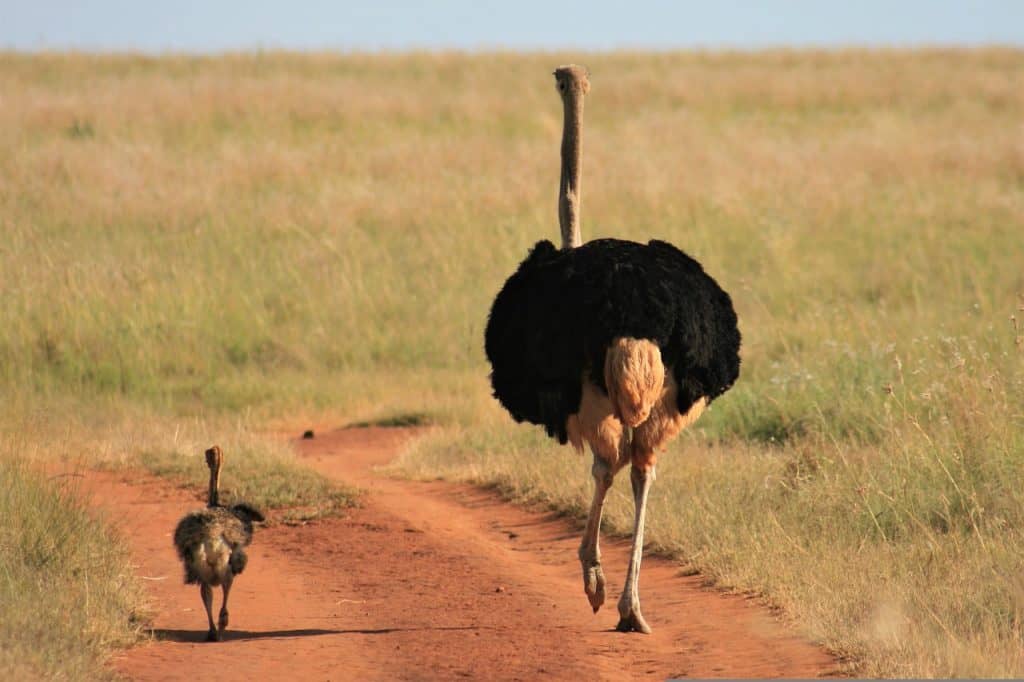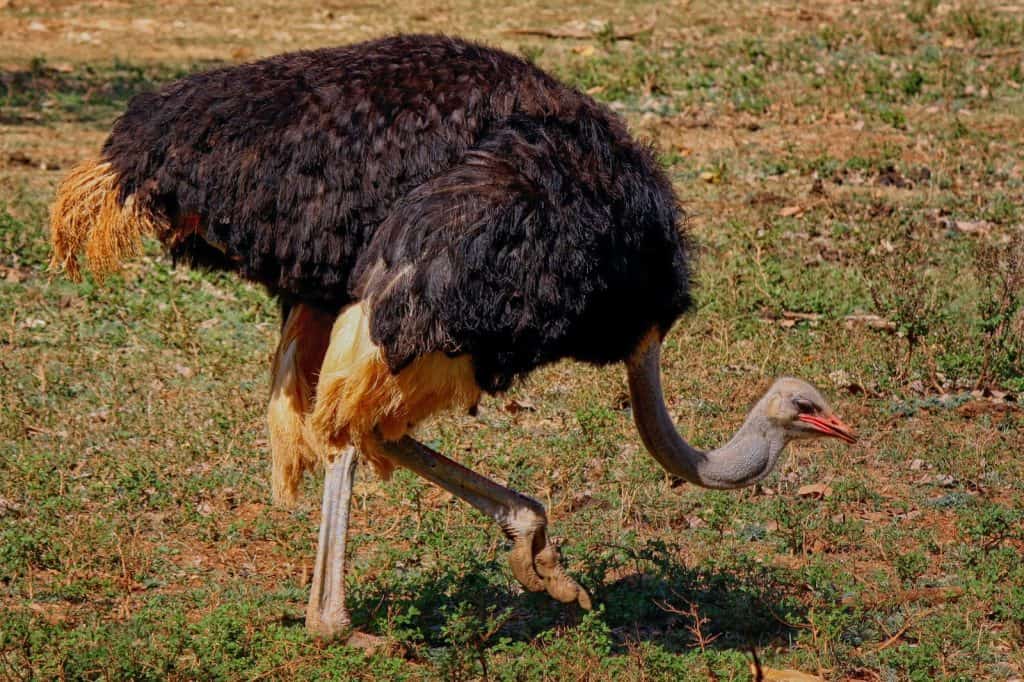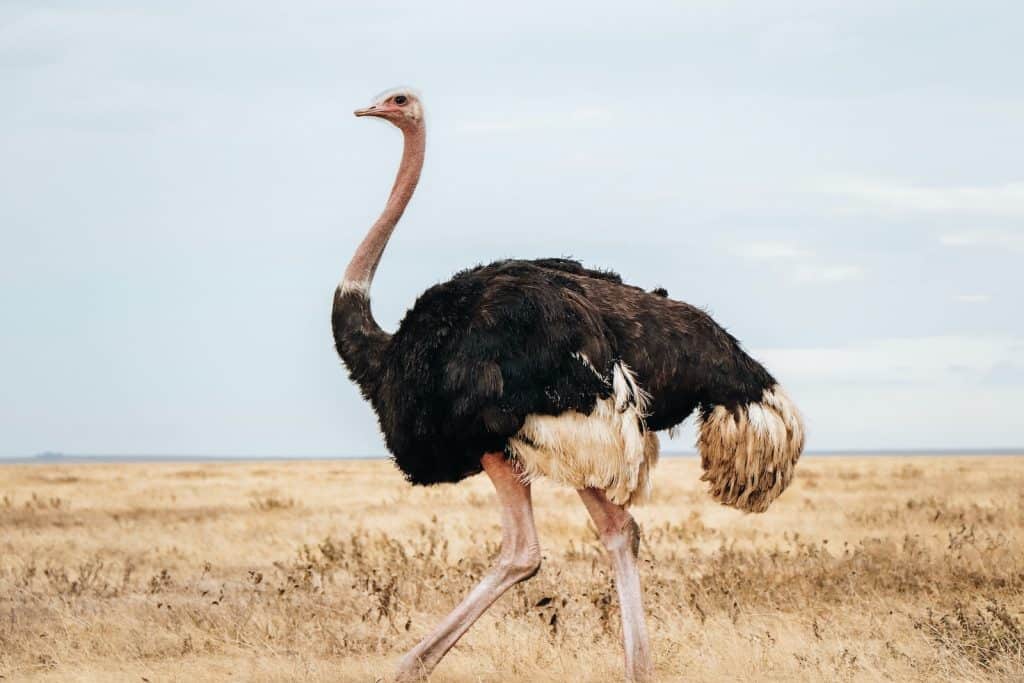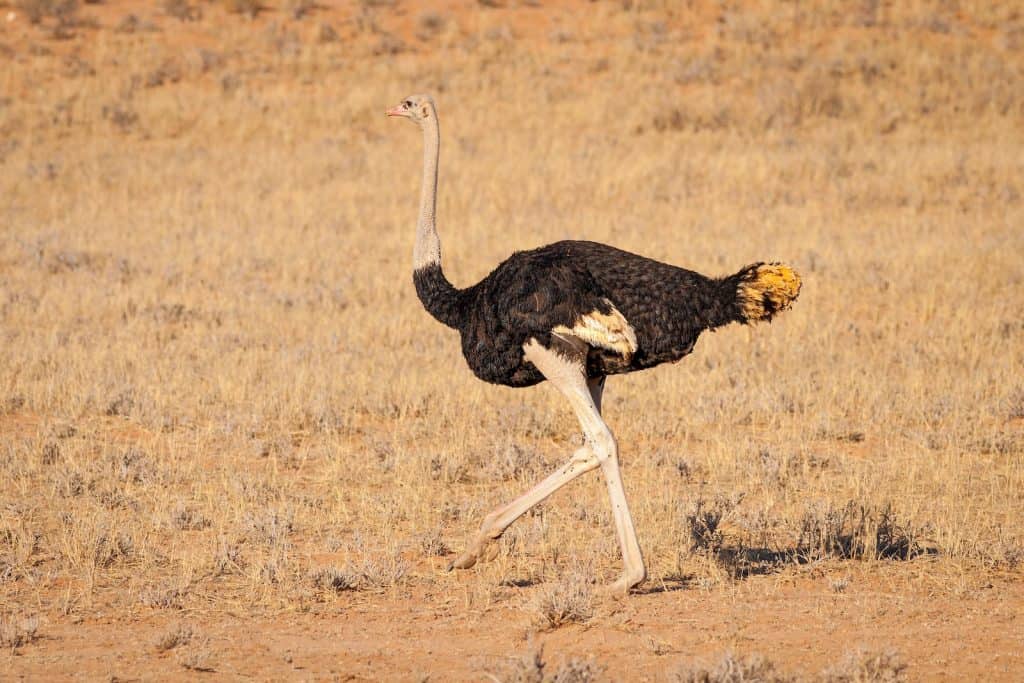
The North African Ostrich is a subspecies of the common ostrich. It is the largest subspecies, the largest of all the common ostriches, and it is also one of the most well-known. It can be found in West Africa and North Africa as well as in conservation and zoo breeding projects around the globe.
Here are some quick facts about the North African Ostrich

| Name of the breed: | North African Ostrich (S. camelus camelus) |
| Where is it from? | Africa |
| Uses: | Captive breeding programs for meat, eggs, leather, and feathers |
| Size of Rooster (Male). | 6.9 to 9.9 ft. 220 to 300 lbs |
| Hens (Females) Size: | 5.7 to 6.2 feet and 198 to 242 pounds |
| Color: | Black with white feathers (male), or brown (female). |
| Lifespan: | 30-40 years; 50-55 in captivity |
| Climate Tolerance: | Hot and dry climates |
| Care Level | Difficult |
| Production: | High |
The North African Ostrich, like all ostrich subspecies, is African in origin. Although it once had a large range, its numbers have decreased in many places. There are many subspecies or races of ostriches, but the North African is the most well-known and largest.
Hunting and habitat destruction likely caused their decline in numbers. In national parks such as the Sidi Tour and Dghoumes National Parks and the Orbata Faunal Reserve, efforts have been made to reintroduce North African Ostriches. The species is extinct in Tunisia and other parts of Africa, but it can be found in small numbers in Senegal and Chad.
Uses
Ostriches can be raised for meat, eggs, and leather. However, this is not the case with the North African Ostrich. This subspecies has been declared critically endangered. It is illegal to keep it in captivity for farming purposes or as a pet.
Ostrich farming should be left to professionals. Domestication of ostriches has not been very successful because they are aggressive, large birds. Ostrich farming is a volatile market, so only a few hundred farms are still in existence.
Appearance and Varieties
There are no color variations in the North African Ostriches. The males are larger and have thicker black feathers, with white tips at the neck, tail, wings, and tail. The males are larger than the females, who are usually brown or gray.
Because of different populations of ostriches, which were once considered distinct species, the North African Ostrich subspecies arose. Researchers now recognize these distinct populations as subspecies or races, such as the North African Ostrich. They are all one species of the common ostrich species.

North African Ostrich Characteristics
The North African Ostrich, like other ostriches, is large and can reach up to 9 feet in length and weigh up to 300 lbs. The Rooster is black with white plumage, including their tails, wings, necks, and tails. Females are either gray or brown. The pinkish-red color of the legs and necks is due to their bareness.
North African Ostriches can become aggressive when threatened and are often ill-tempered. They can be unpredictable and territorial even when held in captivity. They may also be more dangerous when they are competing for mates during the breeding season.
Population/Distribution/Habitat
The North African Ostrich can be found in western and northeastern Africa. Although it once covered large areas of the natural range, including Ethiopia and Sudan to the east, Mauritania to the west, Senegal to the west, and north to Egypt to the south, the ostrich has since disappeared from large swathes of its natural range.
Although this adaptable bird is found in open fields and savannahs, the Israeli-introduced North African Ostriches thrive in semidesert, plains, and grasslands. Sources claim that the North African Ostrich, which is part of the Sahara Conservation Fund, is critically endangered.

Are North African Ostriches Good For Small-Scale Farming?
Ostriches can be raised in small-scale agriculture for meat, eggs, or leather, but North African Ostriches live in captivity at zoos. They are kept in captivity as part of conservation and reintroduction projects.
The North African Ostrich is one of the most well-known ostrich subspecies. Like other ostrich species, it is found in Africa. However, some areas have been affected by habitat loss and hunting. Today, there are small numbers in northern and western Africa. Captive breeding programs as well as reintroduction efforts are underway to restore wild populations in national parks or wildlife reserves.
Is it possible to find ostriches in North Africa?
North African ostriches may be found in broad plains and savannahs, particularly in Africa’s Sahel region. The introduced North African ostriches dwell in Israel’s grasslands, semi-deserts, and plains.
What do ostriches in North Africa eat?
Their plumage combines nicely with the sandy terrain, giving the impression that they have buried their heads in the sand from a distance. Ostriches primarily consume plants, roots, and seeds, but will also consume insects, lizards, and other critters found in their often harsh environment.
Are ostriches hostile?
When confronted, ostriches may become violent rather than flee, especially if trapped, and they may also strike if they feel the need to defend their children or territory.
Are ostriches sexually active?
Ostriches are polygamists, with the male selecting three to five hens (female ostriches) to mate with. Mating normally takes place before the rainy season and lasts around 5 months. The ostrich is a bisexual, complicated species.
How long do ostriches live?
The birds have been taught for saddle and sulky racing, but they fatigue quickly and are unsuitable for training. They thrive in captivity and can live for up to 50 years. The ostrich is a member of the ratites, a group of flightless birds.
Ostrich eggs are edible?
Yes, ostrich eggs are edible and may be consumed. One egg has around 2,000 calories. It has more magnesium and iron than a chicken egg, but less vitamin E and A.
Why aren’t turkey eggs eaten?
Culinary considerations can contribute to the scarcity of turkey eggs. Turkey eggs have a thicker and stiffer exterior membrane than chicken eggs, making them more difficult to break. Furthermore, most recipes are written to accommodate the quantity of liquid in a chicken egg.
Do ostrich eggs repel spiders?
Because the whole ostrich egg repels spiders by material emittance through the eggshell pores, NO HOLES should be created in the egg before hanging or exhibiting it. The use of empty ostrich eggshells or shattered ostrich eggshell fragments is ineffective.
What is the value of an ostrich egg?
One ostrich egg has around 47% protein and over 2000 calories.
Why is the North African ostrich at risk of extinction?
The North African Ostrich (Struthio camelus camelus) has been declining rapidly over the last 50 years as a result of hunting for feathers and food, egg collecting, and habitat destruction. However, the IUCN Red List still classifies the ostrich as “Least Concern.”